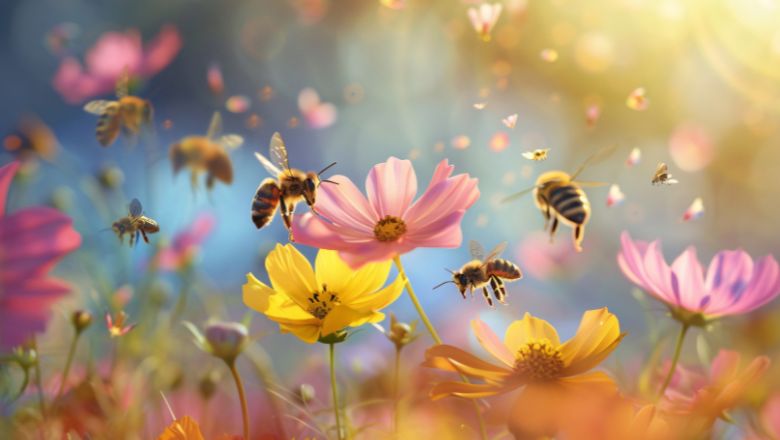Threats to Bee Populations: Habitat Loss, Pesticides, Climate Change, and Diseases

Despite their reputation as the bane of picnickers everywhere, bees are incredibly important to our ecosystem, and they’re currently in trouble. As critical workers maintaining the health of ecosystems and agriculture, bees play a vital role in the reproduction of many of our flowering plants, thanks to their superlative skills as pollinators. From fruits to vegetables, seeds and crops, bees hold the survival of innumerable plant species between their tiny, furry feet, tirelessly maintaining our biodiversity and food sources.
So anything that’s a threat to bees is not just wielding a scythe over our ability to eat honey, but risking the global agricultural economy.
Given how essential they are, it’s quite surprising that more people aren’t concerned, or even aware, of the alarming decline in bee populations worldwide. The loss of bees directly threatens the food security and biodiversity of the planet, so what’s causing our bees to dwindle? And how can we fix it?
Habitat Loss
One of the biggest threats to bees is habitat loss. As urban areas around the world have expanded while agriculture and industry has developed, the natural habitats of bees, which they depend upon for survival, have been fractured. Forests are cleared, meadows and open fields are developed, and suddenly the diverse flora bees rely on for nutrition disappears. At the same time, natural vegetation is replaced with urban sprawl, making it harder for bees to find suitable habitats.
Pesticides
While agricultural pursuits have long since harnessed the chemical power of pesticides to protect crops, they have the unfortunate side effect of also harming bees. Neonicotinoids, in particular, can be extremely detrimental to bee populations as they are systemic pesticides, which are absorbed by plants and distributed throughout the plant tissue, including the nectar and pollen bees eat. When exposed to these chemicals, bees struggle to forage, navigate, and reproduce due to the adverse effect pesticides have on their nervous system.
Alternative Pest Control Methods
Reducing our reliance on these harmful pesticides is essential if we want to protect our bee populations. Organic farming practices that don’t rely on the use of synthetic chemicals offer a far more sustainable and less harmful approach. Another solution is integrated pest management (IPM), which combines biological controls, crop rotation and habitat management to minimise the need for chemical intervention. Bee-friendly pesticides are also in development, which should offer farmers a way to protect their crops from pests without risking the very bees needed to pollinate them.
Climate Change
One of the many side effects of climate change is a shift in flowering seasons, which is causing plants to bloom earlier or later than usual. While the plants may have changed when they’re flowering, the bees haven’t changed when they are active, creating a mismatch between when bees are actively searching for food sources, and when plants are flowering to provide them. The shift means there is less of the nectar and pollen bees rely on available during critical periods in their life cycles. For species like solitary bees, which have a very short lifespan, it’s particularly problematic as they’re far more vulnerable to change. The plants also suffer as a result of this, as there aren’t many bees around to pollinate them when they’re flowering.
Another way climate change is impacting bees is through habitat displacement caused by rising temperatures that are forcing bees to move to higher altitudes or latitudes. For alpine and arctic bees, as well as other species that have adapted to cooler environments, this is particularly devastating. As habitats shrink, bee populations are fragmented, reducing their genetic diversity and leaving them more vulnerable to disease. Bees are also slow to adapt, making it tough for them to survive environmental changes.
Extreme Weather Events More frequent droughts, floods, and storms caused by climate change are disrupting bee populations. Droughts reduce the availability of flowering plants, while floods and storms can destroy habitats and disrupt foraging. Harsher winter conditions also increase bee mortality rates, particularly affecting honeybee colonies that struggle to survive through severe seasons.
There are methods that can be used to mitigate the impact of climate change on bee populations, including using more sustainable agricultural practices like crop rotation and agroforestry. Reforestation and fighting to preserve natural ecosystems can also help to regulate local climates, giving bees the consistent food sources they need. By protecting our ecosystems we can support bee populations as they continue to struggle in the face of global warming.
Diseases and Parasites
As if all that wasn’t enough to contend with, bees are particularly susceptible to diseases and parasites, especially the Varroa destructor mite. Varroa mites feed on a bee’s haemolymph, leaving them weak and vulnerable to viruses like deformed wing virus. Since mites spread rapidly through and between colonies, they have the potential to wipe out entire populations of bees if they’re not rapidly controlled.
Other pathogens like Nosema, which is a fungal infection, can damage bees’ immune systems and give them digestive troubles, while other viral diseases, like chronic bee paralysis virus, have the potential to completely devastate colonies. It’s particularly problematic if those bees are also being exposed to pesticides.
Finally, there is Colony Collapse Disorder (CCD), which occurs when worker bees suddenly disappear. This is thought to be due to a combination of diseases, pesticides, and environmental stressors. While some progress has been made in reducing the reported incidents of CCD, the underlying causes are still a major concern, and researchers are working hard to combat these problems by breeding disease-resistant bees, improving hive management, and promoting genetic diversity to enhance resilience and colony health.
The Threats To Our Bees
Clearly, bees are facing far more problems than seems altogether reasonable for a creature barely the size of one’s thumbnail. Not only are the threats to bees numerous, they’re also interconnected threats, each one feeding into the others. Together, they create a perfect storm of problems contributing to declining bee numbers worldwide, to the point many species are now on the brink of collapse.
If we’re going to tackle these issues we need to hit them from all angles, with governments, farmers, scientists, and even individuals having a role to play in protecting and restoring bee populations. Promoting sustainable farming practices, regulating harmful pesticide use, restoring natural habitats, and supporting research into disease-resistant bees are all critical. On a personal level, we can all do more to help bees by cultivating bee-friendly habitats for them wherever possible. Leaving grassy areas to grow wild and sewing them with bee-attracting flowers that can provide a diverse range of food sources for the bees in your local area is a great place to start.
So, before you break out the mower next spring, consider how much your local bees can benefit from a restrained hand, and a generous sewing of lavender, foxglove, aster and rosemary (among many others!).




Responses